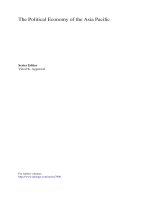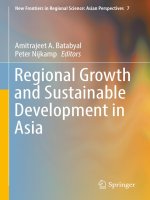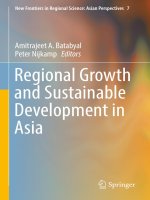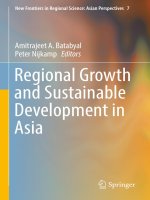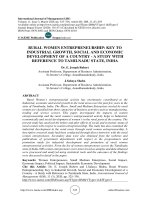Economic growth and economic development 179
Bạn đang xem bản rút gọn của tài liệu. Xem và tải ngay bản đầy đủ của tài liệu tại đây (66.36 KB, 1 trang )
Introduction to Modern Economic Growth
In addition to models of multiple equilibria, we will also study models in which
the realization of stochastic variables determine when a particular economy transitions from low-productivity to high-productivity technologies and starts the process
of takeoff (see Section 18.2 in Chapter 18).
Both models of multiple equilibria and those in which stochastic variables determine the long-run growth properties of the economy are attractive as descriptions
of certain aspects of the development process. They are also informative about the
mechanics of economic development in an interesting class of models. But do they
inform us about the fundamental causes of economic growth? Can we say that the
United States is rich today while Nigeria is poor because the former has been lucky
in its equilibrium selection while the latter has been unlucky? Can we pinpoint their
divergent development paths to some small stochastic events 200, 300 or 400 years
ago? The answer seems to be no.
U.S. economic growth is the cumulative result of a variety of processes, ranging from innovations and free entrepreneurial activity to significant investments in
human capital and rapid capital accumulation. It is difficult to reduce these to a
simple lucky break or to the selection of the right equilibrium, while Nigeria ended
up in a worse equilibrium. Even 400 years ago, the historical conditions were very
different in the United States and in Nigeria, and as will discuss further below, this
led to different opportunities, different institutional paths and different incentives.
It is the combination of the historical experiences of countries and different economic
incentives that underlies their different processes of economic growth.
Equally important, models based on luck or multiple equilibria can explain why
there might be a 20-year or perhaps a 50-year divergence between two otherwiseidentical economies. But how are we to explain a 500-year divergence? It certainly
does not seem plausible to imagine that Nigeria, today, can suddenly switch equilibria and quickly achieve the level of income per capita in the United States.2 Most
models of multiple equilibria are unsatisfactory in another fundamental sense. As
in the simple example discussed above, most models of multiple equilibria involve
2Naturally,
one can argue that reforms or major changes in the growth trajectory are always
outcomes of a switch from one equilibrium to another. But such an explanation would not have
much empirical content, unless it is based on a well-formulated model of equilibrium selection and
can make predictions about when we might expect such switches.
165



